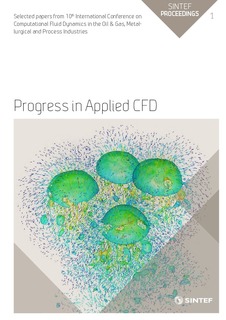| dc.contributor.author | Witt, Peter J. | |
| dc.contributor.author | Feng, Yuqing | |
| dc.contributor.author | Davis, Mark P. | |
| dc.date.accessioned | 2017-11-08T08:18:14Z | |
| dc.date.available | 2017-11-08T08:18:14Z | |
| dc.date.issued | 2015 | |
| dc.identifier.isbn | 978-82-536-1433-5 | |
| dc.identifier.isbn | 978-82-536-1432-8 | |
| dc.identifier.issn | 2387-4295 | |
| dc.identifier.uri | http://hdl.handle.net/11250/2464788 | |
| dc.description.abstract | Over a thirty year period the HIsmelt process has been developed as an alternative to the traditional blast furnace for the production of pig iron. This process involves the injection of fine iron ore and non-coking coal particles into a molten iron bath though a number of wall lances. These jets induce substantial mixing and splashing of molten droplets into the top space of the vessel due to the substantial volume of gas generated within the bath. Control of heat transfer, reactions and the complex multiphase fluid dynamics is critical to successful operation of the process. Since inception computational fluid dynamics has played an important role in scale-up and process optimisation (Davis et al. 2003, Davis and Dry, 2012). A “Bath model” has been developed which focuses on the smelt-reduction processes occurring within the bath volume of the HIsmelt vessel (Stephens et al. 2011). As this model is a transient multi-component Eulerian-Eulerian model with Lagrangian particle tracking for the coal and ore particles, it requires a substantial computational effort. For this reason (and due to the large thermal inertia of the liquid bath) earlier versions of the model have been isothermal. Particles enter the molten iron bath at close to ambient temperature. Heating of both the particles and gas stream by the bath will require a finite time and cause local cooling around the particle jet. To investigate this effect the bath model has been extended to include convective heat transfer between the bath, gas and particles, and radiation within the gas cavity. This paper reports on the incorporation of thermal effects into the model and presents results showing their impact. | nb_NO |
| dc.description.sponsorship | ACKNOWLEDGMENTS. The authors would like to thank HIsmelt Corporation for permission to publish this work, and in particular Dr Rod Dry for his long-standing support and technical inputs to the modelling effort. | nb_NO |
| dc.language.iso | eng | nb_NO |
| dc.publisher | SINTEF Academic Press | nb_NO |
| dc.relation.ispartof | Selected papers from 10th International Conference on Computational Fluid Dynamics in the Oil & Gas, Metallurgical and Process Industries | |
| dc.relation.ispartofseries | SINTEF Proceedings;1 | |
| dc.subject | CFD | nb_NO |
| dc.subject | Multiphase heat and mass transfer | nb_NO |
| dc.subject | Process metallurgy | nb_NO |
| dc.subject | HIsmelt process | nb_NO |
| dc.subject | Iron Making | nb_NO |
| dc.subject | Thermal Radiation | nb_NO |
| dc.title | Modelling thermal effects in the molten iron bath of the HIsmelt reduction vessel | nb_NO |
| dc.type | Chapter | nb_NO |
| dc.description.version | publishedVersion | nb_NO |
| dc.rights.holder | © 2015 SINTEF Academic Press | nb_NO |
| dc.subject.nsi | VDP::Technology: 500 | nb_NO |
